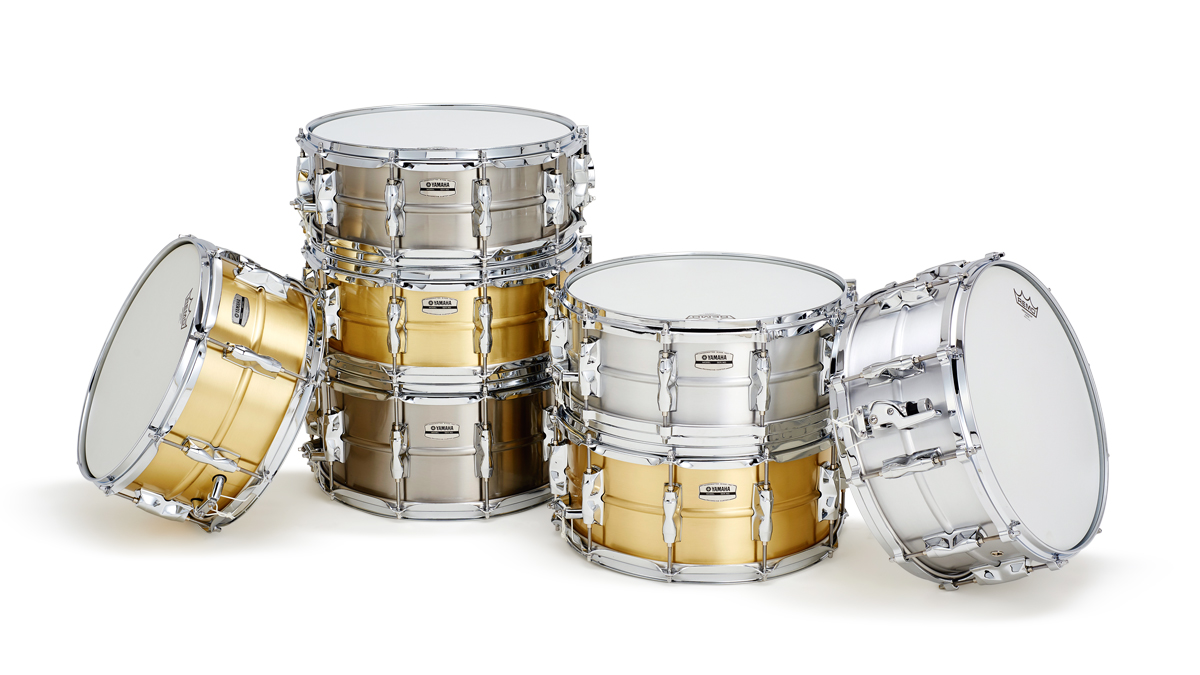MusicRadar Verdict
A well thought-out and superbly built collection of snares in steel, brass and aluminium that will fire up just about any musical situation.
Pros
- +
Fantastic build.
Cons
- -
Very few.
MusicRadar's got your back
Updating and relaunching its most famous and critically successful series - the Recording Custom - was a big deal for Yamaha back in 2015/16.
Accompanying the kit is a set of seven Recording Custom metal snare drums, designed again with input from number one endorsee, Steve Gadd. It’s fair to say that where the original RC9000 series of birch drums took the world by storm and were the benchmark for 1980s kits, the accompanying snare drums, although equally well made, garnered less acclaim.
In re-imagining its RC metal snare range Yamaha addresses any perceived weaknesses, offering the most popular metals, and coming in with attractive prices. In fact, Yamaha has cannily made the price for each size the same no matter which metal you choose. So it really comes down to your preference of tonality.
Build
The snares encompass three metals: stainless steel, aluminium and brass. There are 14"x51/2" models in all three metals, 14"x61/2" aluminium and brass, 14"x7" steel, plus a 13"x61/2" brass. Whichever you choose the metal is 1.2mm thick. And, in the case of the aluminium shells, seamless. The steel and brass shells have butt-joined welds, just about visible inside.
Steve Gadd already had his own series of Yamaha metal shell signature snares, but working closely during the three-year redesign period of the Recording Custom series he was adamant that the new shells should have a convex (outward) centre bead.
Previous Yamaha drums had concave beads, but the convex bead is a feature of Ludwig’s Supraphonic drums, which Gadd was well known for playing during his earlier, stellar session career. Thus with their 10 new centre lugs (eight on the single 13" brass drum) and outward centre beads the drums do bear a resemblance to Ludwig’s equivalent drums, and there is no shame in that.
There are several other features that do single out the Yamahas. The aluminium shell drums have 3mm gauge die-cast aluminium hoops, while the brass and steel drums have triple-flanged hoops but they are heavy weight 2.3mm Dyna Hoops.
The strainer - the bit that lets down many a snare drum - is Yamaha’s proven Q-Type, which is an excellent mechanism. Stocky yet elegant, sure and smooth in operation.
In fact, construction-wise everything is impressive. Shells are spot-on round, 45° edges, smooth and level, there are even 2.4mm deep snare beds. Chroming is truly stunning all-round and the finish and attention to detail is as exemplary as we have come to expect from Yamaha.
Hands On
To a large extent every drummer will have their own personal take on the type of sound that each metal imparts. Steel is heavy and hard - and this is reflected in the sound, which is loud and resonant. That density also leads to sensitivity and the slightest featherweight touch is picked up and then transmitted.
Even with their 3mm die-cast hoops the two aluminium drums are much lighter, half the weight of the steel. The aluminium timbre is bright and breezy, always sprightly, like the metal itself. In fact, there is a high-end ping to watch out for that may need a bit of judicious damping.
The chrome-plated cast aluminium hoops dazzle and we love the way they respond to cross-sticks and rim-shots with a pure chime that feels at one with the shells. Tuned down a touch, the deeper 61/2" aluminium, especially, has a dark, fat quality, but it is always somehow tauter than the three brass drums.
Brass is deeper and warmer, and yet ringier, looser, bangier and less controlled. There’s a hint of wild abandon...
Brass is deeper and warmer, and yet ringier, looser, bangier and less controlled. There’s a hint of wild abandon to the sound, the brass shells seeming perkier, with a fruity, complex timbre, hence the adjective ‘musical’, which often accompanies descriptions of brass drums.
Beyond these attributes, the choice of sizes further extends the series’ adaptability and range. While you can’t go wrong with any of the standard 14"x5½" models, the 6½" pair has more meat, while the 7" steel is a powerhouse that, whether tuned rather lower or higher, always thunders.
Also ballsy, the 14"x6½" brass hints at a bell-like quality. The 13"x6½" brass is the odd one out, the single inch smaller diameter and extra depth making it tubbier and more middly.
A rather cool bonus is the optional 10 strand snares that come with each 14"x51/2" drum. Changing from the standard 20 to these Gadd-favoured 10-stranders makes the sound tighter and drier. Swapping out on the aluminium and steel drums you get exactly what you expect - the aluminium even drier and tauter, the steel darker and harder. On your better days, you might even start to think you’re Steve Gadd!
“Every note counts and fits perfectly”: Kirk Hammett names his best Metallica solo – and no, it’s not One or Master Of Puppets
Ranked: Bon Iver's albums, from Sable, Fable to For Emma, Forever Ago
“Its mission is simple: unleash the power of any amplifier or line-level source without compromise”: Two Notes promises a “watershed” in tube amp control with the Torpedo Reload II










